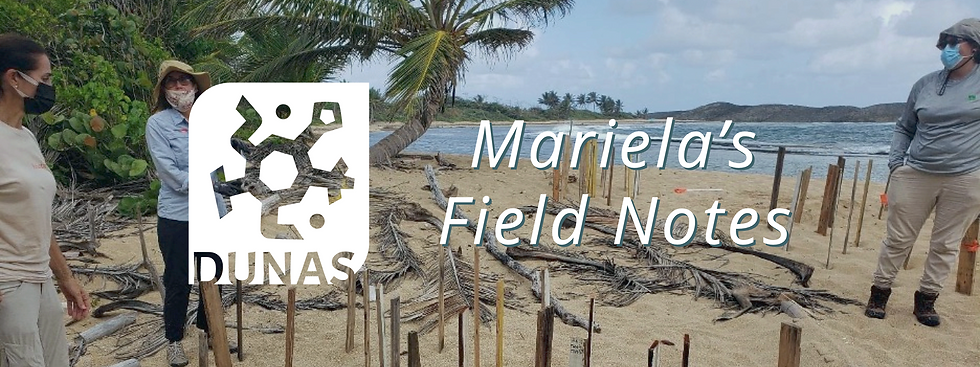Mariela Declet Pérez, a Project Lead for the DUNAS project, is back with another update from the field. Establishing a baseline of information allows the DUNAS team to track how the dune and it’s associated flora and fauna evolve over time. Read about the first census done at Dune #2, and what the team found in today’s blog!

Durante el trabajo de campo de hoy se realizó el primer censo de vegetación y fauna en la Duna #2. Para el mismo, establecimos tres transectos bases para la toma de datos de vegetación, a pesar de que esta duna no tiene tanta vegetación en la parte central de ella, este primer censo nos da un panorama para así evaluar y proceder con la reforestación de esta. Parte de la vegetación que vimos más para los perfiles este y oeste de la duna fueron uva playera y una que otra verdolaga. Desde que llegamos pudimos apreciar en la duna las huellas de cangrejos y cobitos, así como la activa presencia y movimiento de la iguana común de Puerto Rico. During today’s field work, the first vegetation and fauna census was carried out in Dune #2. We establish three base transects for the collection of vegetation data, even though this dune does not have so much vegetation in the central part of it, this first census gives us an overview to evaluate and proceed with reforestation efforts. Some of the vegetation that we saw for the east and west profiles of the dune were seagrapes and the occasional beach purslane. From the moment we arrived, we were able to appreciate the tracks of crabs and cobitos (hermit crabs) on the dune, as well the active presence and movement of the common iguana of Puerto Rico.
Otra actividad que realizamos fue poner más tablas a los sistemas de biomimética ya establecidos y reforzamos las canaletas de bambú que se colocaron en el suelo de la duna. Estas canaletas de bambú nos han de servir como promontorios de arena para sembrar verdolagas. Una vez terminamos esta, proseguimos a recoger la basura que vimos en el camino hacia la duna, lo que nos lleva a todavía tenemos trabajo por hacer en la parte de educar al público que visita esta área. Another activity that we carried out was to put more boards to the already established biomimetic systems, and to reinforce the bamboo gutters that were placed on the floor of the dune. These bamboo gutters are to serve us as promontories of sand to plant beach purslane. Once we finished, we continued to collect the garbage that we saw on the way to the dune, which leads us to still have work to do in the part of educating the public that visit this area.
El día fue uno bien productivo y, debido a la buena y excelente dinámica de los voluntarios, tuvimos tiempo hasta para preparar más maderas para continuar reforzando el sistema de biomimética y crear letreros educativos. The day was a very productive one and, due to the good and excellent dynamics of the volunteers, we even had time to prepare more wood to continue reinforcing the biomimetic systems and create educational signs.


En esta foto tenemos flores de maga en nuestro pelo, simbolizando y rindiendo homenaje a nuestra nueva campeona olímpica Jasmine Camacho-Quinn. In this photo we have maga flowers in our hair, symbolizing and paying tribute to our new olympic champion Jasmine Camacho-Quinn.

This project is made possible through a 2018 Climate Adaptation Fund grant from the Wildlife Conservation Society (WCS) entitled, “Puerto Rico se Levanta: Learning from extreme events to build and sustain a resilient future". Support to establish the Climate Adaptation Fund was provided by a grant to the WCS from the Doris Duke Charitable Foundation.








